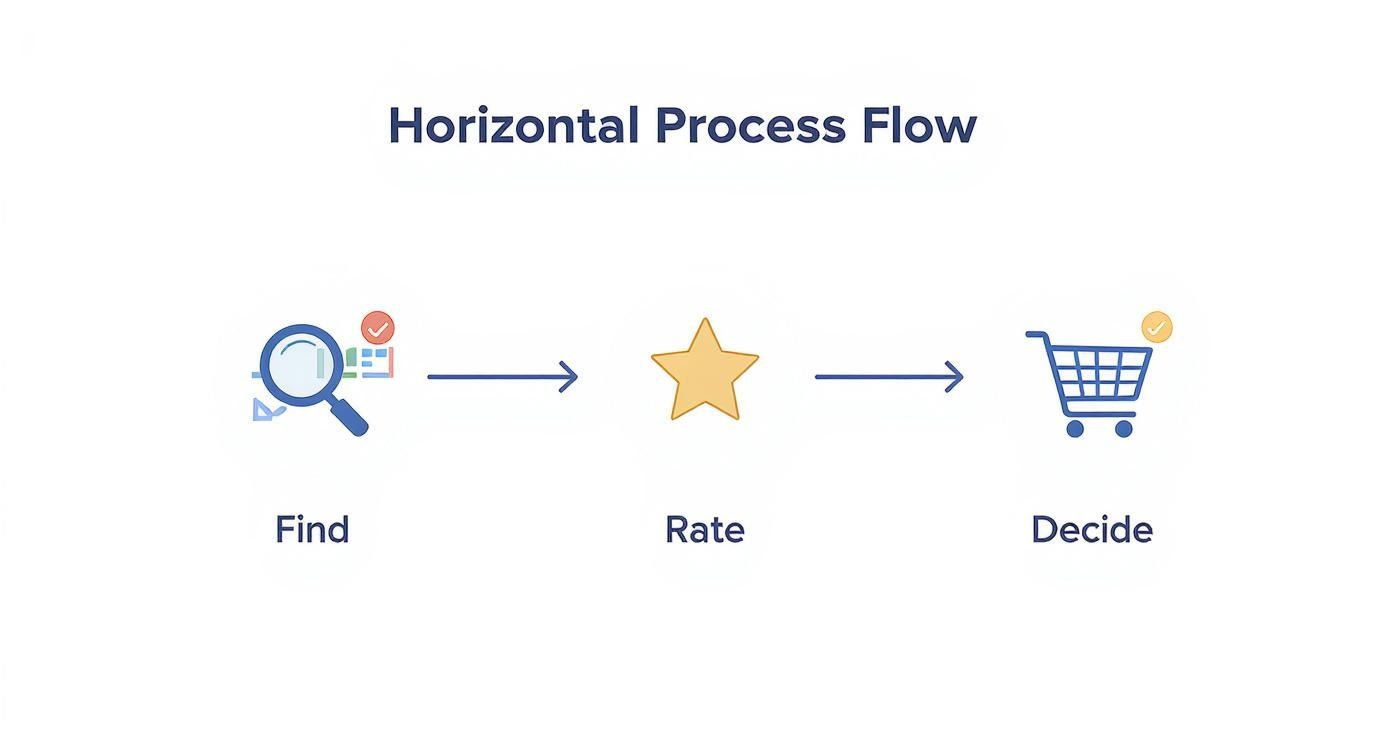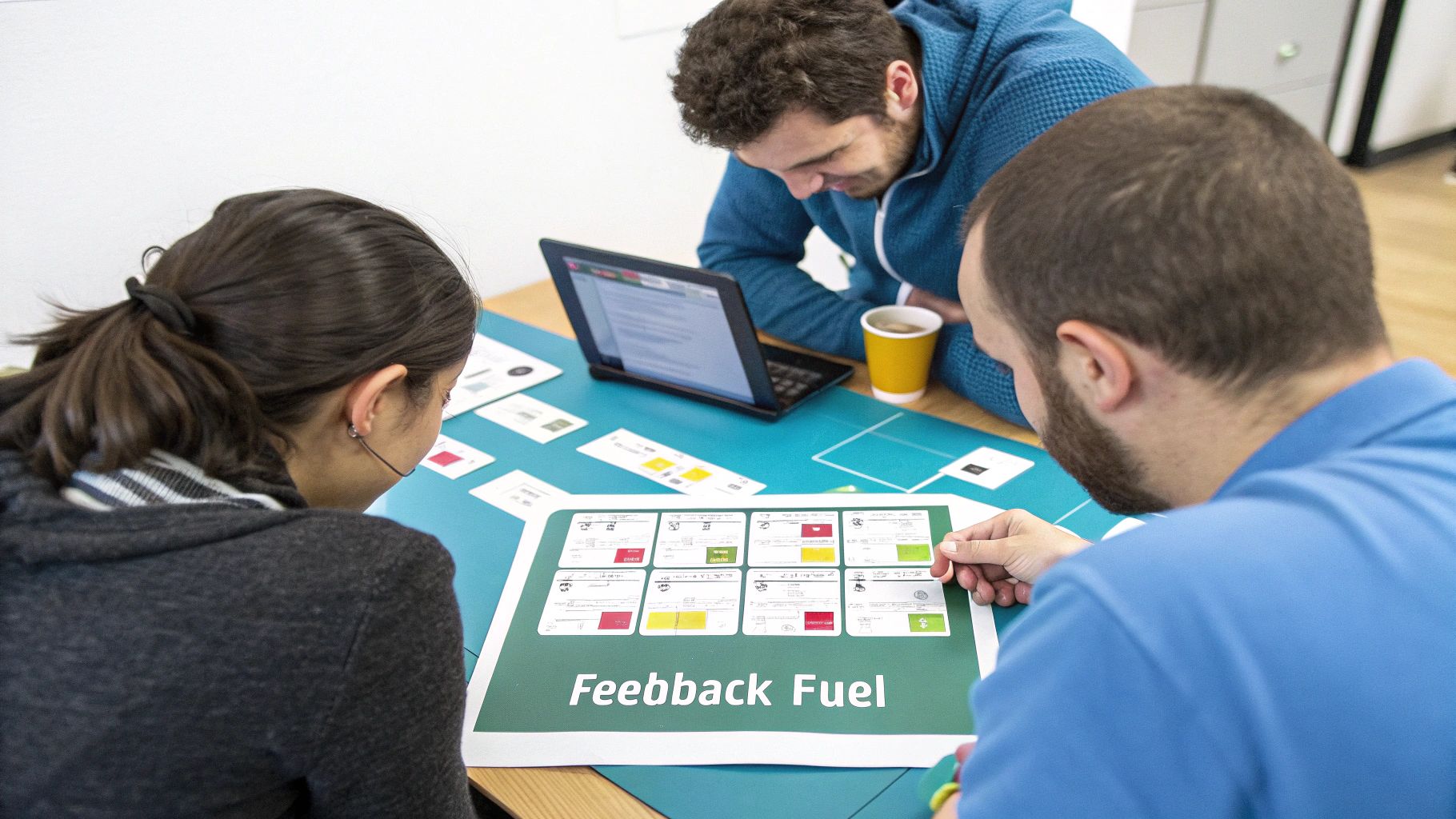
Reputation management on social media isn't some fluffy PR exercise. For a founder, it’s a core business function that directly impacts your bottom line. It's about monitoring what people are saying and actively shaping that conversation. Forget theory—this is a practitioner's guide on exactly how we do it inside BillyBuzz.
Why Social Reputation Is Your Bottom Line
As founders, we're hardwired to fixate on the product, chase growth, and keep the fundraising pipeline full. But at BillyBuzz, we treat our social reputation with the same life-or-death urgency as our cash flow.
Why the intensity? Because we've seen how a single angry tweet or a negative Reddit thread can torpedo a sales lead we spent weeks cultivating. Your brand's reputation isn't some fluffy marketing metric; it's a hard-nosed driver of revenue and survival.
This isn't about vanity or chasing likes. It's about drawing a straight line from online chatter to your bank account. Every comment, review, and mention paints a picture that potential customers are looking at to decide if they can trust you. A solid reputation builds that trust long before your sales team even gets on a call. A bad one? That creates a wall of skepticism that’s nearly impossible to climb.
The New Minimum for Customer Trust
Let's be clear: online reviews are the bedrock of reputation management on social media. A massive 93% of consumers say reviews directly impact their decision to buy something.
The standards have gotten incredibly high, too. A recent study found that 92% of people won't even consider a business unless it has at least a 4-star rating. That means one or two bad reviews can do serious damage, making proactive management a non-negotiable.
This new reality means you can't just hand off your social media to an intern and forget about it. It has to be treated like the critical business function it is.
At BillyBuzz, we see every social media interaction as a data point. A positive review validates our direction, while a negative comment is a free consultation on how to improve our product. Ignoring this feedback is like ignoring your most critical customers.
If you're looking for a complete roadmap to get ahead of the conversation and actively manage your brand's digital story, check out a definitive guide to online reputation management. It’s all about building a system to protect your most valuable asset.
Building a Proactive Social Listening Dashboard
Stop playing defense with your social media mentions. It's time to get ahead of the conversation. At BillyBuzz, our entire approach to reputation management on social media is built around a proactive listening dashboard. We don’t wait for a crisis to start simmering; we’re set up to catch the very first whispers of smoke.
This isn't just theory. This is a peek directly into our internal playbook for building a system that cuts through the noise and gives us intelligence we can actually use. Forget drowning in a sea of irrelevant mentions. The secret is getting really good at writing precise boolean queries and setting up smart, context-aware alerts in your monitoring tools.
The whole process boils down to a simple, repeatable workflow: find the mention, figure out how important it is, and then decide on the right way to respond.

This workflow helps us jump on critical conversations immediately while making sure we're not wasting time on chatter that doesn't matter.
Our Core Alert Configurations
To get started, we build search queries that are specific enough to weed out the false positives right away. For instance, just tracking "BillyBuzz" is way too broad. We use more complex strings to get cleaner results.
A basic brand mention alert for us might look something like this: ("BillyBuzz" OR "billybuzz.com") AND NOT ("job" OR "career"). That simple addition filters out all the hiring-related talk, which our HR team handles separately. We apply the same kind of logic to keep an eye on our competitors, letting us see their wins and stumbles in real time.
When it comes to sentiment, we create triggers based on specific keywords that signal how urgently we need to act. These words are what help us tell the difference between a minor gripe and a full-blown crisis in the making.
- Urgent Negative Keywords: "scam," "broken," "disappointed," "warning," "fraud," "terrible experience"
- Positive Opportunity Keywords: "recommend," "alternative to," "switched from," "love this"
- Industry Topic Keywords: We also track conversations around the core problems our product solves, like "reddit lead generation" or "find customers on reddit."
We treat our listening dashboard as our company’s early-warning system. It’s not just a marketing tool; it’s a firehose of raw, unfiltered product feedback and competitive intelligence that shapes our entire business strategy.
Our Internal Alert Rule Configurations
Here's a snapshot of the specific alert rules we run internally. This setup allows us to monitor our brand health, keep tabs on competitors, and get an early heads-up on potential issues before they escalate.
| Alert Type | Primary Keywords | Negative Modifiers | Sentiment Trigger | Action Priority |
|---|---|---|---|---|
| Brand Health | "BillyBuzz", "billybuzz.com" | "job", "hiring", "career" | "angry", "sad", "disappointed" | High |
| Crisis Watch | "BillyBuzz", "our CEO's name" | "interview", "conference" | "scam", "fraud", "warning" | Immediate |
| Competitor A | "Competitor A", "competitorA.com" | "vs BillyBuzz" | "love", "hate", "switched from" | Medium |
| Feature Request | "BillyBuzz" + "I wish", "feature" | "positive" or "neutral" | Low (Product Team) | |
| Sales Opportunity | "alternative to" + "Competitor A" | "looking for", "need help" | High (Sales Team) |
This table isn't static; we review and tweak these rules every quarter to make sure they're still pulling in the most relevant conversations and filtering out the noise effectively.
Expanding Your Monitoring Reach
You can't just monitor one or two platforms and call it a day. The average social media user is active on 6.84 different platforms every month. With over 5.4 billion users spread across the globe, a single negative post can snowball into a massive problem if you don't catch it quickly.
Reddit, for example, is a high-value community for us. We use our own tool for this, but the principle works with any good monitoring platform. We have alerts set up that pipe any important mentions directly into our team’s Slack channel for immediate review. If that sounds useful, you can see exactly how we do it and set up Slack alerts for Reddit mentions in our step-by-step guide.
While you can always start with a platform's built-in search function, dedicated monitoring tools are what truly give you an edge. They’re what allow for the complex queries and automated alerts that turn a flood of data into a real strategic advantage. This kind of proactive setup is how you stop reacting and start leading the conversation.
Finding and Engaging in Niche Conversations
https://www.youtube.com/embed/ocaUSvZjaRE
So, your social listening dashboard is humming along, and you’re catching every direct mention of your brand. That's a solid foundation. But the conversations that really shape your reputation often happen quietly, in corners of the internet where your brand isn't tagged at all.
This is where the real work of reputation management on social media begins. These discussions take place in niche communities where people get brutally honest about the problems your product is supposed to solve. While platforms like X and Instagram are crucial, dedicated communities on Reddit, Quora, and industry-specific forums are where you'll find the most candid feedback from your ideal customers and power users. Engaging here, however, requires a completely different playbook.
Our Go-To Subreddits for Real Talk
Here at BillyBuzz, we practically live on Reddit. It’s not just a lead source for us; it’s our primary channel for building our reputation from the ground up by listening to what people actually need. We've spent years curating an internal hotlist of subreddits that consistently yield valuable, unfiltered conversations. We don't just track our brand name—we keep a close eye on customer pain points and what people are saying about our competitors.
Here are a few of the communities we check every single day. The goal isn’t just to pounce on sales opportunities, but to immerse ourselves in the language and frustrations of our audience.
- /r/SaaS: This is the watering hole for SaaS founders and pros. The discussions are usually high-level, covering everything from marketing stacks and growth strategies to emerging industry trends.
- /r/marketing: A much broader community, but it’s an absolute goldmine for seeing how marketers discuss their real-world challenges, like brand monitoring and lead generation.
- /r/startups: You want raw, honest talk from founders who are deep in the trenches? This is the place. Monitoring this subreddit gives us a direct line into the daily struggles our core users face.
- /r/sales: Essential for understanding the friction points for sales teams, especially when the conversation turns to lead quality and the effectiveness of prospecting tools.
The trick to finding your own valuable subreddits is to search for the problems you solve, not just your brand name. Put yourself in your customer's shoes. What terms would they use when they're fed up with a competitor's tool and looking for a better way?
The "Give First, Ask Later" Approach
Jumping into one of these communities and immediately pitching your product is the digital equivalent of crashing a dinner party and shouting through a megaphone. You won’t just be ignored; you’ll likely get shown the door. The only way to succeed is to lead with value.
Community members, especially Redditors, have a razor-sharp sense for marketers in disguise.
Our engagement strategy is deceptively simple: find a problem you can genuinely solve, and solve it, right there in the comments. Don't link to your product. Don't even mention your company. Just offer a detailed, helpful answer that shows you know what you're talking about.
We have a hard-and-fast rule at BillyBuzz: our first five interactions in any new community must be pure, unadulterated value. Zero self-promotion. This is how we build credibility and earn the right to be part of the conversation.
Only after we've established ourselves as helpful members of the community do we even consider mentioning our tool, and only when it’s the perfect solution to a specific problem someone is asking about. This long-game approach shifts your position from a salesperson to a trusted expert. You're not just managing your reputation; you're actively building it, one thoughtful comment at a time.
If you want to master this strategy, you can learn how to get customers from Reddit with our detailed guide.
Crafting Responses That De-escalate and Help
Let’s be honest: a bad response is often worse than no response at all. When you're in the trenches of social media, the words you choose can either put out a fire or throw gasoline on it. I’ve spent years refining our response frameworks here at BillyBuzz, and I want to pull back the curtain and share our internal playbook with you—founder to founder.
This isn't about having a library of generic, copy-paste answers. It's about building a communication strategy rooted in empathy. The real goal is to make the person on the other side of the screen feel heard and understood, even when they're angry or completely off-base.

Our Internal Response Frameworks
We've found that most incoming mentions fall into a few core categories. For each one, we have a foundational approach that guides our team's tone and initial actions, rather than a rigid script they have to follow.
The golden rule is simple: acknowledge publicly, resolve privately. Here’s a look at how we tackle the most common situations.
The Angry Customer: This is always top priority. Your first job is to de-escalate the situation immediately. Start by acknowledging their frustration and validating their feelings, then quickly guide the conversation to a private channel.
- What we say: "I'm really sorry to hear about the frustrating experience you've had. That's definitely not the standard we aim for. I'm sending you a DM right now to get your account details so I can personally look into this and make it right."
The Technical Problem: These folks usually aren't angry; they're just stuck. They need clear, helpful direction without a lot of confusing jargon. The key is to get them to the right person who can actually help.
- What we say: "Thanks for flagging this. It sounds like there might be a bug with [feature name]. Our support team is best equipped to troubleshoot this with you. Could you send a quick email to help@billybuzz.com so we can dig in and get it sorted out?"
This kind of direct, human engagement has never been more critical. With the FTC cracking down on fake reviews, authentic interactions build a level of trust that algorithms simply can't replicate. In fact, 39% of customers now say they only trust brands they've personally interacted with on social platforms. That puts a huge premium on getting these conversations right. You can discover more insights about online reputation management statistics on ReputationX.
Handling Positive and Inaccurate Comments
Of course, not every mention is a crisis. Positive shout-outs are fantastic opportunities to build momentum, while misinformation requires a delicate touch. Both are crucial for effective reputation management on social media.
The Positive Shout-Out
When someone says something nice, please don't just "like" it and scroll on. Take a moment to engage with them personally. It's a simple act, but it can turn a happy customer into a vocal brand advocate.
My rule at BillyBuzz is to always match their energy. If they post an excited GIF, we reply with one. If they leave a thoughtful comment, they get a thoughtful reply. This small touch makes the interaction feel genuine, not like it came from a bot.
- What we say: "This just made our day! We're so thrilled to hear that [feature] is helping you achieve [goal]. Thanks so much for sharing—we really appreciate it!"
The Inaccurate Public Comment
This is probably the trickiest situation you'll face. Your gut instinct might be to jump in and argue, but trust me, that never ends well. The best approach is a gentle, factual correction that doesn't make the other person look foolish. If you can, always back it up with a link to a source.
- What we say: "Appreciate you bringing this up, as it's a common point of confusion. Actually, our [product/policy] works like [correct explanation]. You can see more details on our pricing page here: [link]. Hope that clears things up!"
Turning Negative Feedback into Your Best Asset

Let's be honest. As a founder, your gut reaction to a negative comment is probably to cringe. I get it. But what if I told you that every angry tweet and critical Reddit post is actually a free consultation from your most brutally honest users?
Here at BillyBuzz, we don’t see criticism as a PR problem to be stamped out. We treat it as an essential business intelligence tool.
Shifting your mindset from damage control to data collection is the secret to real reputation management on social media. This raw, unfiltered feedback is a direct pipeline into your customers' biggest frustrations and deepest desires, offering insights that expensive market research often misses. When you start viewing complaints as data points, you can turn a potential crisis into a powerful engine for innovation.
This isn't just about responding politely. It's about building a system to extract real, actionable value from all that noise.
Our Feedback-to-Innovation Loop
We’ve developed a structured process for turning qualitative social media chatter into quantitative insights our product and marketing teams can actually use. It’s a simple loop that ensures no complaint ever goes to waste.
First, every piece of negative feedback gets captured and tagged in our internal system. We don’t just log the comment itself; we categorize it with specific tags that help us spot patterns over time.
- Product Flaw: A feature is broken, isn't working as expected, or is causing errors.
- Service Gap: A customer had a bad interaction with our support or sales team.
- Messaging Issue: A user is confused about what our product does or how a feature works. This tells us we have a clarity problem in our marketing.
- UX Friction: A feature technically works, but it’s clunky, confusing, or just plain difficult to use.
We review all these tagged comments in a dedicated meeting every two weeks. If we suddenly see a spike in "UX Friction" tags all related to our onboarding flow, for example, that immediately becomes a priority for the product team to investigate. This process turns scattered, emotional complaints into a clear, data-backed roadmap for improvement.
Having this kind of structured approach is what makes the difference. If you're looking for a hands-on approach to curating your online presence, these effective social media clean-up steps are a great place to start.
Feeding Insights Back into the Business
Once we've identified a recurring issue, the final—and most important—step is to close the loop. We feed these insights directly back to the relevant teams.
The product team gets a prioritized list of bugs and friction points. The marketing team uses the messaging feedback to refine our website copy and ad campaigns.
This completely transforms your reputation management on social media from a reactive, defensive task into a proactive driver of growth. You're no longer just protecting your brand; you're actively making your product better, your messaging clearer, and your customers happier. We also use these insights to fine-tune our monitoring, learning how to distinguish minor grumbles from genuine threats.
You can dive deeper into how we do this by reading about social listening for crisis alerts in our guide.
Got Questions? Here’s What We Tell Founders
Even the sharpest founders run into the same hurdles when they start getting serious about managing their reputation. It's one thing to have a plan, but another thing entirely to handle the day-to-day grind. We get these questions all the time at BillyBuzz, so here are the straight-up answers we give, based on what we've seen work.
How Much Time Should a Founder Really Be Spending on This Each Week?
Look, you're building a company, so time is your most precious asset. For a founder just starting out, aim for a focused 30-60 minutes a day.
This isn't about getting lost in the social media void. It’s a surgical strike: check your listening dashboard for any red flags, jump on critical mentions, and do a quick sweep of the top 2-3 forums where your ideal customers hang out. Consistency beats volume every single time. That direct pipeline to raw, unfiltered customer feedback is pure gold in the early days—it's market research no one else on your team has.
What's the Best Tool if Our Budget Is Basically Zero?
If you can only pick one tool, the answer is to pick a few smart, free ones. You can build a surprisingly solid listening post for $0 that will catch the conversations that matter most.
Here's the no-cost starter pack:
- Google Alerts: A classic for a reason. Set it up for your brand name, your name, and your main competitors. It’s your baseline for monitoring the wider web.
- Native Social Search: Don't underestimate the search bars on X and LinkedIn. Create and save searches for your brand name so you can check in with a single click.
- Manual Forum Checks: Pick the top two or three subreddits or industry forums where your audience lives. This is where the real talk happens, and you need to be there.
Sure, paid tools give you fancy analytics and automation, but this simple combo is more than enough to keep your finger on the pulse when you're starting out.
Here at BillyBuzz, our mantra is this: Acknowledge publicly, resolve privately. This simple rule of engagement shows everyone you’re on top of things without turning a customer issue into a public spectacle. It stops the bleeding immediately and lets you fix the actual problem one-on-one.
When Do I Reply in Public vs. Take It to the DMs?
This one trips people up, but it's pretty straightforward. Your first move should almost always be a quick, public reply.
Think something like, "Hey, we're really sorry to hear you're running into this and want to get it sorted. I've just sent you a DM to get some details." That one public comment immediately shows other people scrolling by that you're responsive and you care. It contains the issue.
From there, you move the actual problem-solving to a private channel—DMs, email, a support ticket, whatever works. This keeps a potentially messy back-and-forth from derailing your public feed. The only real exception? If it’s a simple, factual question that others might have too. In that case, a clear public answer is a service to the whole community. Knowing which conversation to have where is the secret to effective reputation management on social media.
Tired of manually hunting for customers on Reddit? BillyBuzz uses AI to pinpoint relevant conversations and pings you in Slack or email in real-time. You'll never miss a chance to engage again. Start finding your next customers today.
